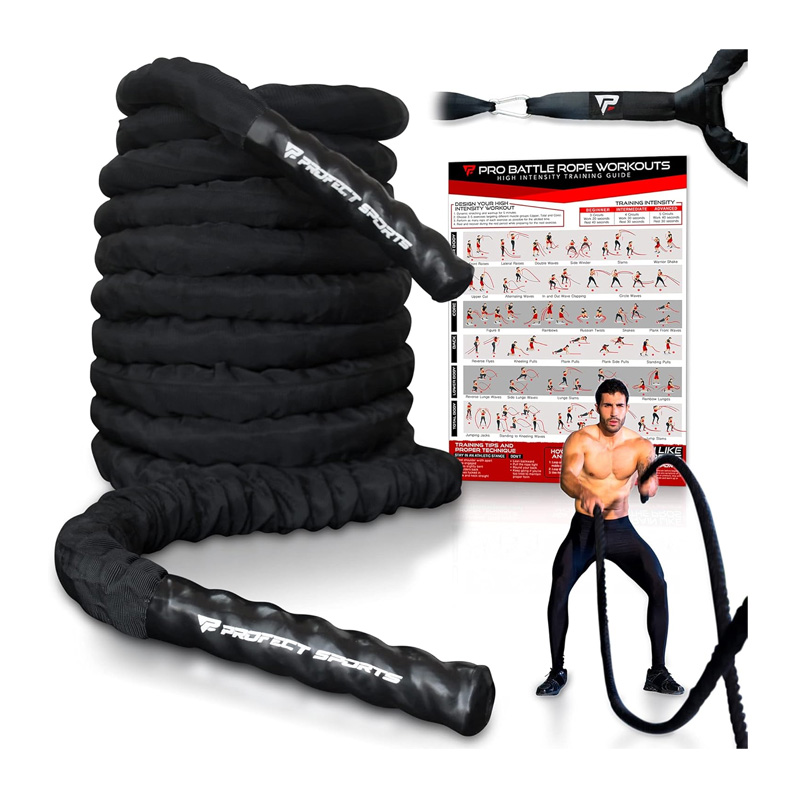How to Use Battle Ropes: Beginner’s Guide to Training, Exercises & Results
Discover the best training tips, exercises, and how to get real results at home or in the gym.
What Makes Battle Ropes So Powerful?
Battle ropes aren’t flashy machines or complicated programs. They’re brutally simple—and that’s exactly why they work. They challenge your entire body.
But beyond muscles, it’s the cardio punch that surprises people. You can sprint with ropes. Slam for 20 seconds and feel like you’ve run a mile. And they’re versatile. No matter your age, fitness level, or setup—battle ropes fit in. They’re perfect for home gyms, garage setups, or backyard burnouts.
Your arms and shoulders drive the motion
Your core braces against the pull
Your legs stabilize everything
Choosing Your Rope (And Why It Matters)
Picking the right rope isn’t about looks—it’s about how it fits your goals. I started with a 1.5-inch thick, 30-foot rope. It felt heavy enough to challenge me, but not so thick it turned every wave into a wrestling match.
Length matters:
30 ft – Ideal for beginners and small spaces
40 ft – Balanced challenge and flow
50 ft – For bigger spaces and longer wave cycles
Thickness matters more than you think:
1.5 inches – Easier to grip, great for conditioning
2 inches – Grip strength monster; not beginner-friendly
Material makes a difference:
Go for poly dacron—it’s durable, flexible, and won’t leave fibers everywhere like natural manila ropes do.
Gear Up and Get Going
If you’re ready to take the leap, don’t wait. You don’t need a gym membership. You don’t even need a workout app. Just grab a rope and find a spot to anchor it—tree, pole, heavy kettlebell, fence post—whatever works.
Advanced home gym users
- 3-strand thick training rope
- Heat-shrink ends
- Easily roll up for storage
Beginner to intermediate
- Double-layer protection
- Humanized design
- Convenient setup
Intense Workouts
- Heavy-duty design for performance
- Secure grip
- Premium materials
Learning the Language of Ropes
Battle ropes aren’t about flailing wildly (though we all start there). They’re about rhythm. Timing. Control. When you find your groove, it’s like dancing with fire.
Four Moves That Changed My Game
You don’t need 20 variations. Start with these four, and you’ll build serious conditioning fast.
Alternating Waves
Each hand creates its own wave, like you're playing a drum solo. This builds coordination, endurance, and rhythm. It's the move I always return to.
Double Waves
Both hands rise and slam together. Simple, yes—but it’ll cook your shoulders in seconds.
Side-to-Side Slams
You swing the ropes like a giant steering wheel left to right. Great for your obliques and core rotation.
Power Slams
Lift the ropes overhead and smash them down like you're hammering the earth. This one feels primal—and hits everything from legs to lats.
The Beginner’s Battle Plan
So how do you turn rope chaos into results? Simple: short, consistent, high-effort sessions. Here’s the weekly structure I followed when I started:
Day 1 – Learn the Moves
Focus on form. Alternate waves and circles for 20 seconds on, 40 off.
Day 2 – Cardio + Flow
30 seconds on / 30 seconds off for 4 rounds: alternating waves, double waves, slams, and side swings.
Day 3 – Rest or Recovery
Light stretching, mobility work, maybe some walking.
Day 4 – Combo Conditioning
Mix rope work with bodyweight:
- 30 sec waves
- 10 push-ups
- 30 sec slams
- 10 air squats
(3 rounds)
Day 5 – Max Out Friday
Pick your favorite 3 moves. Go hard for 20 seconds, rest 10. Do that for 4 rounds. You’ll be drenched.
Day 6/7 – Optional recovery, yoga, or light rope flow
Keep sessions to 10–15 minutes. That’s it. No fluff. Just power and presence.


